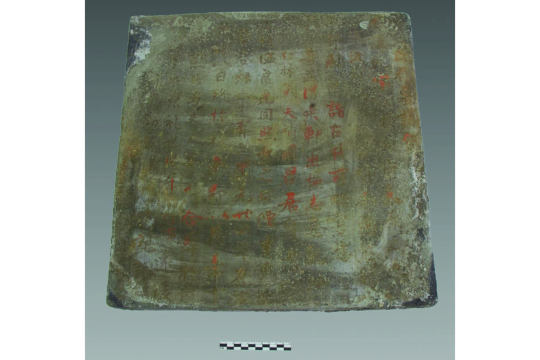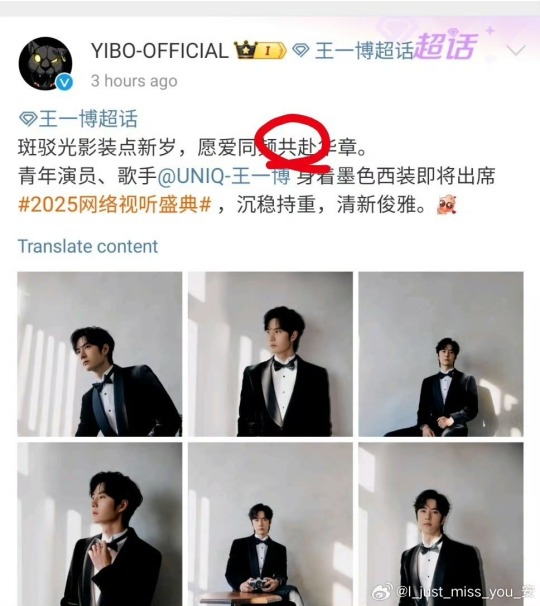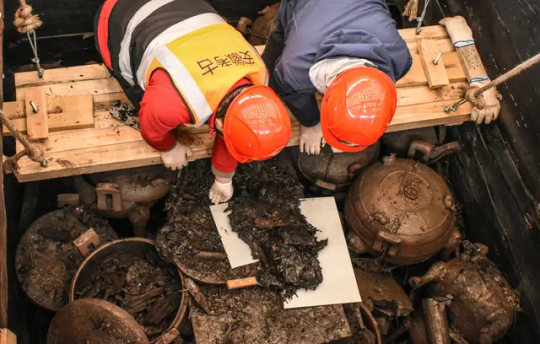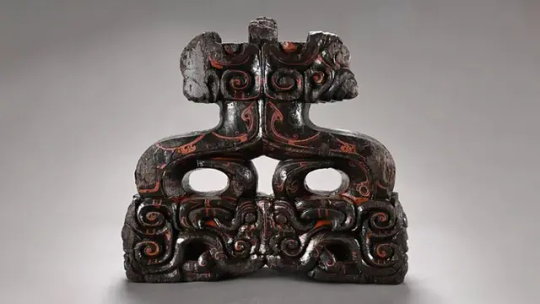#Xinhua news agency
Explore tagged Tumblr posts
Text

A Himalayan monal in Shannan City, Tibet. The pheasant is native to forests and shrublands at elevations of 2,100 metres to 4,500 metres.
Photograph: Tenzing Nima Qadhup/Xinhua News Agency/eyevine
#tenzing nima qadhup#photographer#xinhua news agency#eyevine#himalayan monal#bird#shannan city#tibet#pheasant#nature
71 notes
·
View notes
Text

An elephant family sleeping photographed by a drone for Xinhua News Agency / CCTV.
4 notes
·
View notes
Text


Stunning Tang Dynasty Murals in a Tomb Unearthed in China
A Tang dynasty tomb unearthed in China dates from the 700s, and the murals on its walls give an unprecedented view of daily life at the time.
Archaeologists in northern China have unearthed a centuries-old tomb decorated with stunning murals portraying daily life during the Tang dynasty, which ruled much of central and eastern China from A.D. 618 to 907.
The tomb includes never-before-seen depictions of daily life, including men threshing grain and making noodles.
One of the murals also depicts what appears to be a "Westerner" with blond hair and a beard who probably hailed from Central Asia, Victor Xiong, a professor of history at Western Michigan University who wasn't involved in the discovery, said in an email.
The tomb was discovered in 2018 during roadwork on a hillside on the outskirts of Taiyuan, the capital of China's northern Shanxi province, but archaeologists only reported on the completed excavations last month.
According to an article from China’s government-owned news agency Xinhua, an epitaph in the tomb states it was the burial place of a 63-year-old man who died in 736, as well as his wife.
The tomb consists of a single brick chamber, a door and a corridor. Scenes from life during the Tang dynasty adorn the walls of the tomb, the door, the corridor, and the platform on which the coffin was placed. The domed ceiling of the chamber is painted with what may be a dragon and phoenix.



Tomb guardians
Several figures painted near the door represent the "doorkeepers" or guardians of the tomb; they are wearing yellow robes and some have swords at their waists, according to Xinhua. Other murals portray natural landscapes, as well as men threshing grain, women grinding flour, men making noodles and women fetching water from a well.
They are rendered in the traditional "figure under a tree" style that was popular in the Shanxi region at the time, the South China Morning Post (SCMP) reported. As its name suggests, the style features people carrying out activities underneath beautifully depicted trees.
Many of the figures in the murals look like the same Chinese man and woman, and archaeologists think they may have been the two people buried in the tomb. The woman, in one scene, is dressed in a colorful gown and is leading four horses, alongside a bearded man holding a whip.
Other murals show mountains, trees and camels, and the series of paintings around the coffin may represent the Chinese tomb owner at different stages of his life, Xinhua reported.


Traditional style
The murals in the tomb appear to be well preserved. "The most familiar theme depicted in these murals is that of human figures under trees — a tradition that harks back to the Han dynasty [206 B.C. to A.D. 220]," Xiong said. Similar murals had been found in China's Xinjiang, Shandong, Shaanxi and Gansu regions.
He noted that the blond "non-Han" man leading camels has distinctive clothing. "Based on his facial features and outfit style, we can identify him as a 'Westerner,' likely a Sogdian from Central Asia," Xiong said. (The Sogdians were a trading people along the Silk Road routes between Asia and Europe at the time, living mainly in what are now Tajikistan and Uzbekistan.
He added that many of the murals gave "never-before-seen" representations of daily chores and labor during the Tang dynasty.
By Tom Metcalfe.



#Stunning Tang Dynasty Murals in a Tomb Unearthed in China#Taiyuan#Shanxi province#China#ancient tomb#ancient grave#ancient murals#ancient artifacts#archeology#archeolgst#history#history news#ancient history#ancient culture#ancient civilizations#ancient china#chinese history#chinese art#ancient art
556 notes
·
View notes
Text
Bojunyixiao’s China Internet Audio Visual festival ❤️💛💚
who knew we will be getting another one of these same-event things right after wb night. lol. i honestly didn’t expect it. tho xz was more of the one attending this in the past than yibo so when i wasn’t seeing him in the initial announcements, i thought that this time it’s gonna be yibo coming in. i guess it makes sense that they will both be there cause they had really good projects come out last year + this is a government promoted event. but still. the program is also pre-recorded so they could literally have gone on different days to do their solo performances unless they do a group one with all the attendees.

yibo was the first one to announce his attendance on 1/21 which included a poster and a video invite. in terms of promotion on that day, it seems like he is the primary celebrity for it. the next day, xz also shares the news that he will be there.
and so we have another event to look forward to!


i love how xinhua news agency weibo posted about the festival and mentioned them like this (p2). i love seeing their names together in this way! 🫶🏼
we also had the program the day before and found that the boys are gonna perform at the latter part. with wyb as the second to the last. some photos were also shared but our fave would be the event photoshoot!
matching! holding some sort of camera 📷

not only that, the studio’s captions have something similar 共赴 which means something like go together. so is this for them? they are going together? 😋


looking at the photos too, xz is sparkling! and yibo is his usual baby boy cuter than usual self 🫶🏼
we don’t know what happened behind the scenes but it’s comforting to see them in good condition at events like this.
lastly, in xzs behind the scenes video for his photoshoot, the song used had some audio in it. the message is so sweet! HAHAHAHAHAHA! We imagine this is like XZ. he is not very “sticky” but he loves very deeply 😭😭😭

and the caption with the moon and goodnight at 23:59. p1 is for his bday, when we heard the first snippet of the goodnight song. p2 is weibo night which they both attended and last was yesterday. what a special greeting 🌖



-END.
95 notes
·
View notes
Text





© Fred Lee, Xinhua News Agency
45 notes
·
View notes
Text
Over the past decade, China has invested hundreds of millions of dollars in its international media network. The Xinhua News Agency, China Global Television Network, China Radio International, and the China Daily web portal produce material in multiple languages and use multiple social-media accounts to amplify it. This huge investment produces plenty of positive coverage of China and benign depictions of the authoritarian world more broadly. Nevertheless, Beijing is also aware that news marked “made in China” doesn’t have anything like the influence that local people, using local media, would have if they were uttering the same messages.
That, in the regime’s thinking, is the ultimate form of propaganda: Get the natives to say it for you. Train them, persuade them, pay them—it doesn’t matter; whatever their motives, they’ll be more convincing. Chinese leaders call this tactic “borrowing boats to reach the sea.”
When a handful of employees at RT, the Russian state television network formerly known as Russia Today, allegedly offered to provide lucrative payments to the talking heads of Tenet Media, a Tennessee-based far-right influencer team, borrowing boats to reach the sea was exactly what they had in mind. According to a federal indictment released last week, RT employees spent nearly $10 million over the course of a year—money “laundered through a network of foreign shell entities,” including companies in Turkey, the United Arab Emirates, the Czech Republic, and Hungary—with the aim of supporting Tenet Media’s work and shaping the messages in its videos.
The indictment makes clear that the influencers—propagandists, in fact—must have had a pretty good idea where the money was coming from. They were told that their benefactor was “Eduard Grigoriann,” a vaguely Euro-Armenian “investor.” They tried to Google him and found nothing; they asked for information and were shown a résumé that included a photograph of a man gazing through the window of a private jet. Sometimes, the messages from Grigoriann’s team were time-stamped in a way that indicated they were written in Moscow. Sometimes the alleged employees of Grigoriann’s alleged company misspelled Grigoriann’s name. Unsurprisingly, in their private conversations, the Tenet Media team occasionally referred to its mysterious backers as “the Russians.”
But the real question is not whether the talking heads of Tenet Media—the founders, Lauren Chen and Liam Donovan, who were the main interlocutors with the Russians, but also Tim Pool, Lauren Southern, Dave Rubin, and Benny Johnson—had guessed the true identity of their “investor.” Nor does it matter whether they knew who was really paying them to make videos that backed up absurd pro-Moscow narratives (that a terrorist attack at a Moscow shopping mall, loudly claimed by the Islamic State, was really carried out by Ukrainians, for example). More important is whether the audience knew, and I think we can safely say that it did not. And now that Tenet Media fans do know who funds their favorite influencers, it’s entirely possible that they won’t care.
This is because the messages formed part of a larger stream of authoritarian ideas that are now ubiquitous on the far right, and that make coherent sense as a package. They denounce U.S. institutions as broken, irreparable: If Donald Trump doesn’t win, it’s because the election is rigged. They imply American society is degenerate: White people are discriminated against in America. They suggest immigrants are part of a coordinated invasion, designed to destroy what remains of the culture: Illegal immigrants are eating household pets, a trope featured during this week’s presidential debate. For the Russians, the amplification of this narrative matters more than specific arguments about Ukraine. As the indictment delicately explains, many of the Russian-sponsored videos produced by Tenet Media were more relevant to American politics than to the Ukraine war: “While the views expressed in the videos are not uniform, the subject matter and content of the videos are often consistent with the Government of Russia’s interest in amplifying U.S. domestic divisions.”
But these themes are also consistent with the Trump campaign’s interest in amplifying U.S. domestic divisions. People who have come to distrust the basic institutions of American democracy, who feel aggrieved and rejected, who believe that immigrants are invaders who have been deliberately sent to replace them—these are not people who will necessarily be bothered that their favorite YouTubers, according to prosecutors, were being sponsored by a violent, lawless foreign dictator who repeatedly threatens the U.S. and its allies with nuclear armageddon. On the contrary, many of them now despise their own country so much that they might be pleased to hear there are foreigners who, like the ex-president, want to burn it all down. If you truly hate modern America—its diversity, its immense energy, its raucous debate—then you won’t mind hearing it denounced by other people who hate it and wish it ill. On X earlier this year, Chen referred to the U.S. as a “tyranny,” for example, a phrase that could easily have been produced by one of the Russian propagandists who regularly decry the U.S. on the evening news.
These pundits and their audience are not manipulated by Russian, Chinese, and other autocrats who sometimes fill their social-media feeds. The relationship goes the other way around; Russian, Chinese, and other influence operations are designed to spread the views of Americans who actively and enthusiastically support the autocratic narrative. You may have laughed at Trump’s rant on Tuesday night: “The people that came in. They’re eating the cats. They’re eating—they’re eating the pets of the people that live there. And this is what’s happening in our country. And it’s a shame.” But that language is meant to reach an audience already primed to believe that Kamala Harris, as Trump himself said, is “destroying this country. And if she becomes president, this country doesn’t have a chance of success. Not only success. We’ll end up being Venezuela on steroids.”
Plenty of other people are trying to reach that audience too. Indeed, the Grigoriann scheme was not the only one revealed in the past few days. In a separate case that has received less attention, the FBI last week filed an affidavit in a Pennsylvania courthouse supporting the seizure of 32 internet domains. The document describes another team of Russian operatives who have engaged in typosquatting—setting up fake news websites whose URLs resemble real ones. The affidavit mentions, for example, washingtonpost.pm, washingtonpost.ltd, fox-news.in, fox-news.top, and forward.pw, but we know there are others. This same propaganda group, known to European investigators as Doppelganger, has also set up similar sites in multiple European languages. Typosquatters do not necessarily seek to drive people to the fake sites. Instead, the fake URLs they provide make posts on Facebook, X, and other social media appear credible. When someone is quickly scrolling, they might not check whether a sensational headline purporting to be from The Washington Post is in fact linked to washingtonpost.pm, the fake site, as opposed to washingtonpost.com, the real one.
But this deception, too, would not work without people who are prepared to believe it. Just as the Grigoriann scam assumed the existence of pundits and viewers who don’t really care who is paying for the videos that make them angry, typosquatting—like all information laundering—assumes the existence of a credulous audience that is already willing to accept outrageous headlines and not ask too many questions. Again, although Russian teams seek to cultivate, influence, and amplify this audience—especially in Pennsylvania, apparently, because in Moscow, they know which swing states matter too—the Russians didn’t create it. Rather, it was created by Trump and the pundits who support him, and merely amplified by foreigners who want our democracy to fail.
These influencers and audiences are cynical, even nihilistic. They have deep distrust in American institutions, especially those connected to elections. We talk a lot about how authoritarianism might arrive in America someday, but in this sense, it’s already here: The United States has a very large population of people who look for, absorb, and believe anti-American messages wherever they are found, whether on the real Fox News or the fake fox-news.in. Trump was speaking directly to them on Tuesday. What happens next is up to other Americans, the ones who don’t believe that their country is cratering into chaos and don’t want a leader who will burn it all down. In the meantime, there are plenty of boats available to borrow for Russians who want to reach the sea.
86 notes
·
View notes
Text
Beijing also launched a propaganda barrage. “China’s position is firm and consistent,” a foreign ministry spokesperson stated in remarks carried by the official Xinhua News Agency on Sunday. “There is no winner in trade and tariff wars.” In fact, there are winners. The Chinese regime, however, will not be among them. Trade-surplus countries like China do not have much ammunition in struggles with deficit ones like America. We can see that in the remarks of the oft-quoted Julian Evans-Pritchard of Capital Economics, who stated in a research note that China’s measures were “fairly modest.” They were, he pointed out, “calibrated to try to send a message” to the Trump administration “without inflicting too much damage.” Ultimately, there is not much damage Beijing can inflict, except to itself.
...
As China’s economic problems get worse—the economy is not growing anywhere near the 5.0% pace if it is growing at all—Xi is doubling down on policies undermining the economy. Most important, he rejects the idea accepted most everywhere that consumption should be the basis of an economy. Xi does not want to empower consumers, he does not want to offend powerful blocs in the Communist Party, he wants to build a wartime economy, he wants to protect the interest margins of fragile state banks. To accomplish all these objectives, China’s ideological leader is implementing policies inhibiting consumer spending. This means China, as Scott Bessent said in his Senate confirmation hearing last month, has “the most imbalanced, unbalanced economy in the history of the world.”
...
In these circumstances, Xi Jinping has only one way to rescue the Chinese economy: export more. In practice, he has put the fate of his regime in America’s hands. The United States is by far the world’s largest market, and it cannot be replaced in any realistic time frame. Moreover, both the European Union and so-called “Global South” countries, perhaps inspired by American moves, are beginning to erect tariff barriers to Chinese goods of their own.
Don't even believe the lie that China is a superpower. They're not. They're just another nation dependent on US largesse to survive.
22 notes
·
View notes
Text

📷 中國桂林, Guilin, China 1970’s by Xinhua News Agency 新華社北京 Beijing News
與其想知道何時再去度假,不如建立一個你無需逃離的人生。
Instead of wondering when your next vacation is, maybe you should set up a life you don’t need to escape from.
🎧 🎻 陳蓉暉小提琴專輯 【如詩如畫小提琴 - 伊甸園VOL. 2 】 完整專輯12首
youtube
22 notes
·
View notes
Text
[2025.01.25] Xinhua News Agency - 30-minute conversation with 30-year-old Yuzuru Hanyu

Xinhua News Agency reporter Qian Zheng and Yang Zhixiang
I met Yuzuru Hanyu at a filming base in the northwest of his hometown, Sendai. Away from the ever-changing lights and shadows of the ice, and without the dazzling costume, the two-time Winter Olympic gold medalist in men’s singles figure skating sitting across from me appeared as simple and approachable as a neighbour boy.
Hanyu recently celebrated his 30th birthday and launched his second solo tour, "Echoes of Life," on his birthday. This is the third installment of his solo ice performance series "Ice Stories," following "Gift" and "RE_PRAY," where Hanyu himself serves as both the performer and the executive producer.
Unlike his previous solo ice shows, which featured only two or three new routines each time, "Echoes of Life" consists of 12 major performances, most of which are new. Through these pieces, Hanyu is able to tell a grand story that seeks to answer the profound question, "What is life?" He has been contemplating life ethics since childhood and even studied related courses during university. He has woven his philosophical interests and thoughts on the "meaning of life" into this self-scripted, self-directed, and self-performed "Ice Story."
Hanyu explained, “When I express myself, figure skating is still the first and foremost medium. Because I’ve always used skating, it feels as natural to me as speaking. This way, it’s closer to expressing what I really want to say.”
Since announcing in July 2022 that he would no longer compete in figure skating competitions and instead pursue a career in professional figure skating, Hanyu has devoted more time and energy to expressing himself through his skating programs. He said, “When I was competing, I had to complete jumps to earn points. I was always thinking about elements like footwork and the number of rotations, while also considering how to match the music. Now that I have more freedom, I focus on whether the program expresses the essence of the music and what I most want to communicate."
His pursuit of expression has made figure skating much more than just a sport for Hanyu. "When I create a program, I don’t think about it solely from a figure skating perspective but as a form of expression. I incorporate many different elements and try to absorb content that I find cool and beautiful," he explained.
Without the constraints of competition, he has even experimented with improvisational performances. While all three of his "Ice Stories" were created in collaboration with a top Japanese choreographer, Hanyu believes that truly identical performances cannot be replicated. "When trying to express genuine emotions, improvisation is better," he said.
However, he admits that it’s very difficult to express himself freely. He aims to create new and original movements, but the movements he is most skilled at, those deeply ingrained in his body, unconsciously sneak into his routines. Moreover, he says that figure skating is different from track sports. Even with a simple hand movement, the feet will slide, so sometimes, even if he wants to perform such a move, it is not easy to do so.
Yet, pushing beyond what’s easy and reaching uncharted territory is what this prince of figure skating, who has broken 19 world records and achieved two Grand Slams and a Super Grand Slam, relentlessly pursues.
He told reporters that he now practices about five hours a day on average, sometimes up to six hours, with one day off per week. This is a higher training volume than before. In competitions, a program lasts no more than 4 minutes 30 seconds to 4 minutes 40 seconds, but now he must perform for over two hours continuously. This requires not only muscle strength but also lung capacity.
He trains for explosiveness using weights like barbells and dumbbells, works on building his endurance and focus, and practices breathing techniques, facial expression management, and core strength required for his two-and-a-half-hour performances.
His schedule is packed with almost no complete rest days. He constantly thinks about the content of his performances and engages in imagery training. On the afternoon we interviewed him, he had to face five media outlets for a total of five hours. Even on such a busy day, he was thinking about training afterward. He mentioned that he still enjoys playing video games, but with his increased training load, he doesn’t know what to do on rest days anymore.
Technically, his skills are on par with current competitors, his expressiveness has reached perfection, and his physical strength is also impressive. However, regarding the various speculations about whether he will compete in the 2026 Winter Olympics, Hanyu stated that he has no plans to return to the competitive arena.
"Now, I can finally pursue the figure skating expression I want to see first, skating, jumping, spinning, and so on. When I skate now, the people around me are those who truly want to see me skate, who hope to see me skate. I’ve finally arrived in a world where I can express what I want to express, skate the way I like, and perform skating that I think looks beautiful and fantastic, and receive praise for it. As for going back to competitions, I’m not interested."
Without the direct standards of judges' scores and the value of medals, this professional figure skater says the expectations of the audience are the driving force behind his continuous efforts. The atmosphere at his ice shows and the enthusiasm of the audience serves as his criteria for evaluating his own work.
Hanyu said that it is precisely because the audience always comes to watch his performances that he can keep pushing himself. If he were alone, he wouldn't be able to convey his thoughts to anyone, and such so-called expression would have no value, becoming something hollow. But when there are people to receive his message, and they also expect his performance, that becomes his motivation. "So, I now place great importance on conveying my thoughts to the audience."
Rather than the size of the audience's cheers and applause, Hanyu cares more about the warm atmosphere of the event. "The audience who comes to watch my performances doesn’t focus on whether I succeed or fail, win or lose, they are simply there to enjoy my performance," Hanyu said. "In moments like this, I can truly feel the enthusiasm of the audience, and they are deeply immersed in my story and program. That’s my criterion for evaluation. Because I’m skating for everyone."
It is precisely because of this desire to skate for others that Hanyu often says, "No matter what, I will keep working hard, even if it shortens my life. Otherwise, I won’t be able to accept it." He will repeatedly bow and thank the audience near the end of each performance, even when he is exhausted and struggling to catch his breath. He will also remind the audience to be careful on their way home after the show.
In the past, Yuzuru Hanyu imagined that turning 30 would make him feel like an "old man." However, after the birthday performance for "Echoes of Life," he told reporters that if he were to think in terms of baseball or soccer, 30 would mark the period when experience, feeling, and skills begin to reach their peak.
As he said during the interview, “I do see 30 as a milestone year, but for me, it’s just a simple repetition of December 7th for 30 years. Goals and dreams change every day. For instance, when ‘Echoes’ starts, I focus on performing well in that, but once it ends, I move on to pursue something new.”
In a sport like figure skating, where athletes often retire from competition by 30, most would transition to other roles behind the scenes. But for Yuzuru Hanyu, turning 30 may simply mean he’s one year older. His name may still be associated with many “firsts” in the future.

Source: http://www.news.cn/world/20250125/4efcbf22b5ec483ab436c4d625833c96/c.html
15 notes
·
View notes
Text

so xinhua news agency just released a summary of the best and most memorable film, tv, theatre, and music works in china in the past 10 years. when i click on the 2023 list, i was so confident about three body being mentioned first, and here it is, the first thing you see on the long image for 2023 is three body!!!
i know this show is not for everyone, but it's undeniable that it's going to be one of the most influential tv shows in cdrama history.
also i got this lovely message from a lovely user the other day (i hope it's ok for me to post it here, if not please let me know). you really have no idea how much i appreciate this kind of message. even though we have a tiny fandom here, it makes it all worth it.

i love that people can see my passion, and i also love to see how much people love this show and the cast. i admit sometimes i rant too much about the lack of interest on tumblr, but i'm always grateful for those who stick with my blog and stay in the fandom <3...
i recently came to a conclusion that i just love this show and its cast too much to care about the fandom size anymore, and it's impossible for me to love anything else as much as three body. so if i quit posting about them, i'd really have nothing else to post on here lol. so yep, i'm hoping i can present you with a less "ranty" and more positive kun in the new year <3...
11 notes
·
View notes
Text
🇯🇵 🚨
MASSIVE EARTHQUAKE ROCKS TAIWAN, TSUNAMI WARNINGS ISSUED FOR JAPAN
📹 A massive 7.5 magnitude earthquake rocks Taiwan today, prompting Japan's Meteorological agency to issue tsunami warnings.
The agency told residents of Okinawa Island, Miyakojima Island and Yaeyama Island to immediately evacuate, warning of waves up to 3 meters (9.8ft).
A little while ago, Xinhua News Agency reported tsunami waves of 30cm had reached the Japanese island of Yonaguni.
#source1
#source2
#videosource
@WorkerSolidarityNews
#taiwan#taiwan news#japan#japan news#tsunami#earthquake#ring of fire#asia#east asia#news#world news#global news#international news#breaking news#current events
37 notes
·
View notes
Text

Flamingos appear even more long-legged than usual as they’re reflected in Larnaca salt lake, Cyprus.
Photograph: George Christophorou/Xinhua News Agency/eyevine
#george christophorou#photographer#xinhua news agency#eyevine#flamingos#birds#larnaca salt lake#lake#nature#cyprus
30 notes
·
View notes
Text
🎤 Lando at the Drivers' Press Conference before the Chinese GP:
(The video is from F1Fever on YouTube)
Transcript:
Interviewer: And Lando, what about your expectations coming into the weekend?
Lando: Probably not as high as Suzuka. I think that's our opinion. But still in a good position. I think we've been happy with how the season started. I think we're in a good qualifying battle with Aston, Mercedes, it’s very close and even last weekend ahead of Ferrari, but I think the order is still clear.
And I think in the racing we've done a good job. Not as good as Red Bull but and Ferrari, but I'm a head of Aston and Mercedes. So I think we're in a good spot. This wasn't a great circuit for us in 2019 but many things have changed since then. So I'm so optimistic we can have a good weekend.
Interviewer: What is it about this layout that gives you less confidence?
Lando: The long corners. Just, like, Turn 1. Yeah, this type of corner is just not good for us. Similar to, say, Zandvoort, that kind of experience for us. So yeah, we've got some things to try. And we're constantly trying to improve these areas. But it's an area we know is one of our biggest weaknesses, and maybe we kind of get away with it in qualifying but especially into the race becomes a bigger problem for us.
Interviewer: There were some race day frustrations for you in Japan, but afterwards, your boss Andrea Stella, said that the team can win this year. How quickly do you think you can do that?
Lando: Not anytime soon, that's for sure. I think we can. Right place, right time, if we improve the car how we need to. Honestly, there weren't too many frustrations with Suzuka. I think everything went pretty much as expected. I don't think we did a perfect job and I think we probably should have finished one place higher up, potentially. But I don't think it was far off. We've been the same place all season. We've been behind Red Bull, we've been behind Ferrari and we've been a bit of a step ahead of the other two teams come the race. And that's exactly how last weekend went.
So I don't think there's too many frustrations. But we know the issues, we know what we have to improve. And if we can improve them. I think Andrea is right. I think we can win races this year. And we can be competitive with these other two teams ahead of us. But that's an if. And you know, we have to work hard to improve the car in some of these certain areas, which have been a big challenge for us over the last many years, not just for years, but last many years. But if we can, then I'm confident we can have some good races.
Journalist Questions:
Q1 (Ian Parkes – New York Times):. I don't know if any of you drivers have had an opportunity to inspect the track as yet. But Charles mentioned it earlier, and a couple of other drivers have mentioned it in their media sessions earlier today, that the track has been painted. What does that means pecifically? Do you know? Does it cause any concerns? What issues are you expecting from such a track?
Lando: I have no idea. So I think we have to wait and see honestly, I think that's something new, something we don't think we've seen before, so hard to predict exactly what's going to happen. So I honestly have no idea. So I'll see you tomorrow.
Q2 (Michael Butterworth – Xinhua News Agency) To all the drivers briefly. It's been a while since we've been to the Shanghai circuit. Just keen to hear your thoughts on it. And any particular features that make it especially challenging or memorable for you?
Lando: I always raced here once, but I didn't finish the race. So not the best memories. But yeah, it was still in my first season. So everything was new back then. But it's always been a cool track to drive. Definitely was not my back then. But excited to give it another crack and see what we can do this weekend.
Q3 (Henry Clark – Daily Mail) I was wondering, obviously a lot of tracks that we come to, it's only been a year or so since you've last been here. But for everyone here there has been no race for at least five years. I was wondering what are the unique challenges that brings? Does that make this weekend particularly exciting? Or are there extra worries that come with that?
Lando: I guess just excited. Always excited for every weekend, but especially when you haven't been to a place for a while. For me, I didn't get a proper experience of it back in 2019. So things have changed. I'm a very different driver to what I was back then.
So I'm excited to see what it brings and how the whole weekend pans out I think anyway being a Sprint race and having two opportunities to try and nail the set-up for the first quali and then the set-up for the second quali. I think also there is plenty of opportunity. So I don't think it’s not going to be exciting for anyone. I think there's a lot of opportunities on the table, there's a lot of things that can go wrong at the same time, so excited for all of it.
Q4 (Henry Clark – Daily Mail) With all due respect to some of the more senior drivers, a question to a couple of the younger guys on the panel. When you see Fernando committing his future to racing well into his 40s, how impressive is that dedication? How much does it take to keep doing that? And also, do you see yourselves wanting to race for as long as that in your own careers?
Lando: I’d better be careful what I say. I think it takes a lot of dedication. I don't think anyone thinks Fernando lacks that in any way. I think he shows that with everything that he does in life. Whether it's at the track or away from the track, you know, in different sports or whatever. So it depends what you want to do. Everyone is different.
It's rare that you see someone commit for so long in any sport, you know, he's probably one of the oldest guys competing at the top of any sport in the world and I think to be able to do that at the level that he has done and continues to do, you're probably never going to potentially see it again, you know within Formula 1 and if you do, it's going be extremely rare.
So yeah, I think a lot of respect for that kind of thing. I have no idea if I want to do it in 20 years’ time, if I'm still going strong, but I love where I am now and I continue to do such a thing. Yeah, we'll see.
22 notes
·
View notes
Text


Lavish 2,200-year-old King Tomb Discovered in China
Archaeologists have unearthed a luxurious 2,200-year-old tomb in eastern China, the largest, highest-ranking, and most structurally complex ever unearthed, which may have belonged to an emperor of the state of Chu during a critical period in Chinese history.
Chu was one of the seven Warring States, along with Qin, Han, Wei, Zhao, Qi, and Yan. The unification of these states is recognized as the start of modern China.
The 2,200-year-old Wuwangdun tomb, which is situated in the Anhui Province of East China’s city of Huainan, has yielded over 1,000 artifacts, including figurines, musical instruments, bronze goods, and everyday utensils and lacquerware artifacts, dating to about 220 BC.
At Wuwangdun, one of the largest-scale Chu state archaeological sites, researchers previously uncovered a cemetery spanning 1.5sqkm, with a chariot and sacrifice pits and a tomb, believed to be that of the cemetery’s owner.




The tomb is thought to be the highest-level ancient Chu state tomb ever excavated, and its vast scale, intricate structure, and rich contents suggest it belonged to the state’s emperor.
According to information obtained by the Global Times newspaper from the Institute of Cultural Relics and Archaeology of Anhui Province, based on the size and scale of the tomb, as well as historical records, it is estimated that the owner of the tomb may be King Kaolie of Chu. However, a more accurate determination of the tomb’s occupant will require further extraction of artifacts and analyses of textual evidence.
Meanwhile, the tomb had been looted multiple times throughout history. Anhui was permitted by the NCHA in 2019 to excavate the tomb and salvage its archaeological remains. An official start to the excavation work was made a year later, and it was recognized as a national project to use archaeological research to determine the origins of Chinese civilization.
The Wuwangdun tomb complex, which covers an area of over 140 square kilometers, includes sacrificial pits, chariot and horse pits, accompanying graves, and the main burial chamber (Tomb No. 1). Tomb No. 1 is a large, nearly square, vertical pit tomb with sides that are about 50 meters long. There is a 42-meter-long, sloping tomb passage on the east side.



Around the pit, eight side chambers were found, and a central coffin chamber with several layers of planks covering it was also found. 443 coffin lid planks and the 78 bamboo mats that covered them have been removed thus far. On the planks of the coffin lid, there were about 1,000 ink-drawn characters that represented the locations and purposes of each side chamber.
“The findings can provide an overall picture of the political, economic, cultural, technological and social conditions of the Chu state in the Warring States period,” Gong Xicheng, an archaeologist part of the excavation told Chinese state news agency Xinhua.
“The findings can help us learn about the historical evolution as well as the formation of a unified nation and its culture,” he added.
These discoveries provide systematic archaeological data for studying the high-level tomb system in the Chu state during the late Warring States period (475BC-221BC).
To discover while also preserving the unearthed remains archaeologists worked within a special low-oxygen laboratory built at the site.
By Leman Altuntaş.



#Lavish 2200-year-old King Tomb Discovered in China#Wuwangdun tomb#Huainan China#King Kaolie of Chu#ancient tomb#ancient grave#ancient artifacts#archeology#archeolgst#history#history news#ancient history#ancient culture#ancient civilizations#ancient china#chinese history#chinese emperor#chinese art
97 notes
·
View notes
Text
July CPNs round-up ❤️💛💚

• xz as backing vocals for the song everything is lovely
• clowning about screen protectors
• both of their names together on hs for being posted by xinhua news agency
• same city in Beijing on 7/6 - there was some talk that xz’s flight out has been changed to the 12th, probably to spend more time with wyb who will leave on the 10th. which didn’t happen cause wyb left 7/8 but still got to to spend that time together. some were clowning about how his airport shirt had a crease on it & how that made it seem like it was folded like how xz does it so ya know, is it a sign? lol.
• 7/10 XZS paris vlog clowning: posting so close to yibo’s appearances and similar shots // the two bros focused in the video, paris olympics and torchbearer route.
• 7/12 XZS vlog - possibly texting wyb and little prince figures + snowy mountain ; jacques tati films bgm used
• 7/14 xzs vlog clues! more symbolism and that goose laugh
• walking in the streets of paris
• similarity between tao and yibo showing off a photo of their significant other
• continuing on with the off white with “painting” shirts that xz wears, which is already strike 3 && kind of proves the sdc 3 clowning. he wore this during his off work hours. ⬇️⬇️⬇️⬇️

it follows the pattern 👀👀👀
• 7/15 xzs vlog clowning continues - same place different time / confirmation of the bystander lyrics connection and E142 cue
• NOT TOTALLY CPN BUT ME BEING EMOTIONAL. LOL. SEEING YIBO do that torch really in that simple outfit everyone was wearing. mostly bare faced and all eyes on him. that moment — and then you see him wearing that bome necklace makes me go somft. 🥹🥹🥹🥹 he will go to so many places and experience a lot of things but he will always have a piece of xz with him.

some are getting excited about them with silver jewelry necklace but xz’s is boucheron which he is endorsing. as much as i love jewelry cpns, i always get picky when it’s something they endorse, unless there is an additional clue. but i understand why people got 👀 when they saw that silver chain with GG. unfortunately, this is not the necklace we think it is.


another one is this “couple” / same style jacket they both wore when they went abroad. RBS already explained this and i totally agree with their stand on it. i guess what makes this cpn-y to me is the “style” it, showing how their preferences overlap in clothing. and that’s why we think they have a “shared closet”.

<< previous post
• On 7/19, the booting ceremony of XZ’s new film DeXian JinZhi, the cast was revealed and we learned that Yin Zheng is there. Yin Zheng is WYB’s very close friend, so we will definitely keep an eye out on how he will interact with XZ 😂😂😂😂 and oh, Peng Yucheng is also there! who is Bobo’s friend and someone he fake kissed HAHAHAHAHAHA!!!!! so many common friends!

• some minor cpns from xzs 7/20 vlog + something i forgot to add, same acne studios plain shirt. HAHAHAHAHA! twinning! 👯♀️

• xz vlogs appear to be countdowns 🤔🤔🤔
• BJYX related hs on them speaking goose language! HAHAHAHAHA! we shall remain relevant forever!
• what a nice magazine! our boys! side by side! and it’s like a fanfic cover for pairing wei ruolai and chunsheng!

• them posting for public welfare and in support of the olympics for CCTV ( here and here ) also with mengniu’s short film. i love seeing them supporting the same thing and hopefully they get to collab someday for a common cause 🌎 if there is any type of project they can work together, this may be it, cause fans can’t even be outwardly toxic especially if it’s a government project.
• 7/26/2024 xzs vlog candies
• 7/28 coco crush posts clowning
• 7/29 throwback video uploaded by rufeng
• 7/30 XZS vlog clowning time: dancing like wang laoshi, possible mv for bystander and wonderful world lyrics.
plus some more ⬇️⬇️⬇️
ohhhhh. a snowy mountain or is it? i mean who wouldn’t be taken by that and especially someone like xz. love how he took pictures of it and drew it too. in the post by xzs it’s in the c-position, probably cause it’s drawn by xz but also it’s photo #5/18 WYB.
p3 is also our colors! green (ish), red and yellow!

SEE YOU ALL NEXT MONTH!!!!!
<<< previous post
97 notes
·
View notes
Text








Zheng Qinwen + 2024 Slam Outfits © Erick W. Rasco, Anadolu, Xinhua News Agency, Mike Everton, Daniel Kopatsch, Baptiste Fernandez, Matthew Stockman
45 notes
·
View notes